Titanic Belfast
The crux of Belfast is its shipbuilding history and this museum is the greatest tribute to the most important vessel that the biggest shipbuilding giant (Harland and Wolff) had produced… the Titanic. Of course, the ship gained a lot of extra attention from the fact that she sunk on her maiden voyage but one of the worker’s audio clips inside the museum tartly exclaims “she was fine when she left Belfast”.
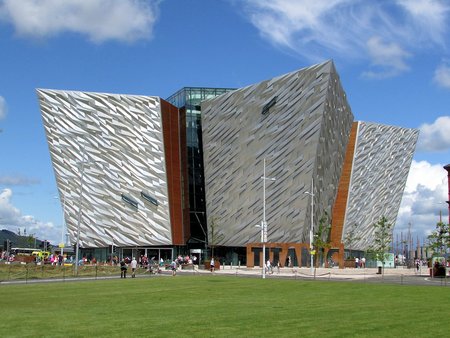
The entire museum is constructed in the form of a trail and the visitor is taken through the great history of Belfast shipbuilding industry and how it impacted Ireland’s economy to the production process of Titanic and Olympic. The intelligent use of technology is the strongest point of the Titanic Belfast museum; there are interactive screens posing quizzes, audio clips from shipyard workers and even a chair car ride through daily life in a shipyard. The 360-degree view of the ship’s deck, engine room to the glass dome atop the grand staircase is done via a fantastic video simulation.
The chance of seeing all 3 classes of cabins in the ship, the main slipways and all those hidden fascinating facts about the Titanic that you never knew about; is an incredible feeling in itself. The presentation of the Titanic Belfast is dazzling enough to have won many awards since 2012 and interesting enough to become one of Ireland’s top attractions.
Play quizzes on the interactive screens, watch original ship dockyard workers spell out their experiences and inspect rare artefacts like the last letter penned down on the Titanic and the menu list of the last meal served on the ship. And if you luckily arrive on a Sunday then do indulge in the marvellous afternoon tea session served at the Titanic Suite near the Grand staircase.
Read: What to see and do at Titanic Museum Belfast
Crumlin Road Gaol
The black basalt and red sandstone structure designed by Charles Lanyon will immediately catch your eye as you approach the Crumlin Road Gaol… it is an excellent example of dark Goth (some will even call it Satanic) architecture. Later you will learn the dramatic design was inspired by London’s Pentonville Prison and its intelligently constructed security system made it the first Irish Prison to have incorporated ‘Single Cell Confinement’ or the ‘Separate System’.
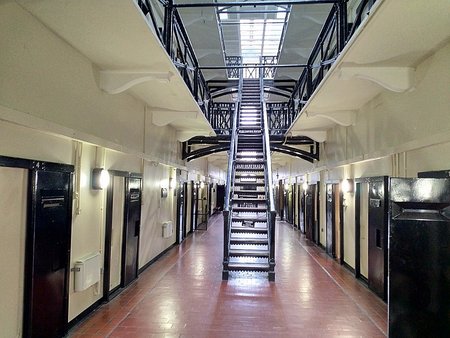
The Gaol has seen many turbulent times in its 150 years plus history; the post potato famine rise in crime, convictions of child and women prisoners, executions, suicides, escapes and political imprisonments. All the eras and the important milestones of the Goals history can be studied as you walk from room to room of the Gaol… they are filled with architectural memorabilia like prison bars and stonework and pictures detailing the history of the place.
The execution chamber with the original noose still hanging there is not for the faint-hearted though it’s a crucial part of the gaol experience. An underground tunnel connects the Crumlin Road Gaol and the courthouse… this was built to straightaway take prisoners from trial to jail. Nowadays the whole route cannot be accessed but you can easily walk halfway if you take the Crumlin Road Gaol tour.
Crumlin Road Gaol offers a bunch of nicely curated tours that let you explore its different facets through different perspectives. For example, you can do the walking tour that takes in the Peace Walls, Courthouse, Crumlin Road Gaol and other landmarks that are tied up with those desperate times in North Ireland’s history that are called ‘Troubles’.
Then there is the Paranormal tour which focuses on the many hauntings, sightings and Paranormal activities that gave the Crumlin Road Gaol its spooky reputation. The in-house restaurant ‘Cuffs Bar and Grill’ offers excellent steaks and fish and chips which you can indulge in if the spirits have not driven your appetite away!
Read: What to see & do in Crumlin Road Gaol and how to take its tours.
Peace Walls
Walk towards Cupar Way Peace Wall and it’s difficult to believe that such a structure could exist in a modern European city. Two streets i.e. Shankill Road and Falls Road and their ancillary neighbourhoods are separated by a 24 feet wall that runs for 800 meters.
There are scores of Loyalist neighbourhoods on the Shankill side who openly display Union flags and whose residents ardently want to remain a part of UK. Switch to the other side and you will find scores of the Irish Tricolours all showing the depth of Nationalist sentiments.
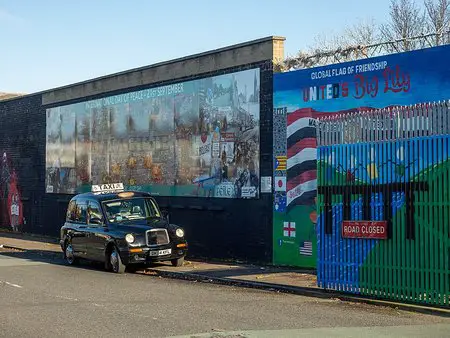
The Peace walls have many famous and well-executed murals that commemorate the causes of both sides. Built as a sort of neutral ground that separated the warring Nationalist and Loyalist sides… the Peace Walls literally wanted to bring in peace. Falls Road art has an Irish historical theme. The Shankhill and Newtownards Road have many Loyalist murals that show the pro-British stance.
Belfast is a small city and its rather stunning to note that there still are almost 50 ‘Peace Walls’ separating Catholic and Protestant areas. Sometimes groups fought over Catholicism and Protestant beliefs but the underlying philosophy was always politics and Civil rights. A lot of blood was spilt and thousands of families were dispossessed around the burning issue of Whether North Ireland should be a part of the UK or the Republic of Ireland. The walls of Belfast are more about ‘keeping the peace’ than demonstrating it.
Though the Cupar Way is what tourists normally see when they go to visit the Peace Wall there are many other Walls and interface areas that provide a deep insight into the history of North Ireland. Places like Alliance Avenue in North Belfast as it divides the Ardoyne area (republican) and Glenbryn estate (loyalist) are also visit worthy!!
Read: All about Peace Walls and Wall Arts in Belfast.
Belfast Castle & Cave Hill Country Park
A trip to the Belfast Castle offers you the rare chance of being a queen or a king for a day. The erstwhile haunt of the Donegal family and the illustrious Shaftesbury family has a sweeping grey staircase and a lovely Scottish renaissance style architecture with turrets and round towers.
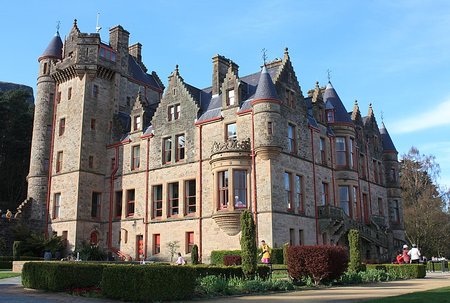
Look for the marvellously preserved 1920’s style bedroom inside the Museum/ Visitor Centre and watch a video about the geology and natural heritage of Cave Hill. For centuries the inhabitants of the castle have been keeping watch from the castle and the beautiful vantage view of Belfast and its landmarks (David and Goliath cranes) will tell you how.
The Castle is surrounded by manicured lawns and an intriguing ‘cat garden’ and there is a great restaurant and gift shop inside. Go beyond the castle and a plethora of activities await you at the Adventure Playground and Cave Hill Country Park. The Cave Hill Country Park has meadows, heath strips, woodland and a stunning cliff face besides two nature reserves. Go for a walk that lets you see Napoleon’s Nose or go for a free orienteering course that’s offered by the Park authorities. This is undoubtedly Belfast’s best all family destination.
Read: Belfast Caste and what to see and do there.
SS Nomadic
People call S.S Nomadic ‘The mini Titanic’ but actually she is so much more!! The entire journey of this tender ship, war vessel and entertainment venue is represented beautifully inside. You can know about Nomadic’s journey right from the time her keel was laid down in Harland and Wolff yard 422 in 1910 to her role as a tender to Titanic in 1912 to her attempts at evacuating French soldiers from German Army and her role as a floating restaurant on the Seine in 1977.
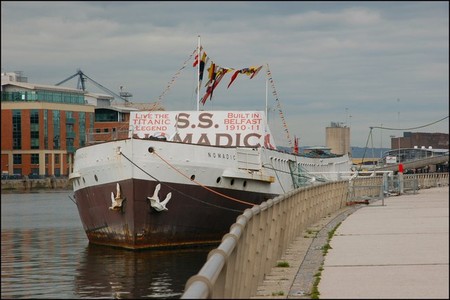
Stories of her abandonment at Le Havre and rescue by Department of Social Development in 2006 and accounts of famous passengers she serviced like Charlie Chaplin, James Cameron, Elizabeth Taylor, Benjamin Guggenheim, Margaret Brown are all put up on display inside the fascinating ship. Unlike the more glamorous and famous Titanic which sank on its maiden journey, the S.S Nomadic served for more than a century in different roles and its ironic to observe that she was built in the same yard of Harland and Wolff as giants like Titanic and Olympic and released from an adjacent slipway.
The S.S Nomadic outperformed all White Star line vessels in her career and is now the last functional vessel of this kind left in the world. The friendly staff at this entertainment hub and historical venue (the present role of S.S Nomadic) will direct the visitors towards the games and puzzles zone in the lower deck and the audio and video section ‘Nomadic Reflections’ in the Third class passenger area.
Numerous interactive boards detailing the history of the vessel, snapshots from her career and milestones in the shipbuilding career of Belfast are put up in strategic points inside the ship as well as dockside. Dress up as nobility and try your hand at manning the ship’s wheel or try to build a ship in an interactive game… there are activities galore inside.
The deck is perfect for a long stroll and the hull’s end calls for a ‘Jack and Rose’ photo. When the journey is over you can buy some S.S Nomadic themed souvenirs inside the pump house that’s now a gift shop. Take an audio tour or buy the entire Titanic experience (titanic Belfast museum and S.S Nomadic); either way, it’s hard not to be bewitched by this experience. If you have brought the combi ticket for S.S Nomadic and Titanic Museum and are unable to visit the former on the same day then don’t worry… you can just shift your visit to the next day!!
Read: The complete story of SS Nomadic and what to see & do there
Belfast City Hall
The Baroque revival styled magnificent Belfast City Hall is one of those rare City Halls of the UK that are interesting enough to become a top attraction. The Portland stone body of the building is topped by glimmering copper domes; making it a photographer’s delight. Inside, there are lavish installations of marble, huge stained glass windows, valuable artefacts, priceless gifts sourced from all across the world and a retelling of the history that made Belfast what it is today.
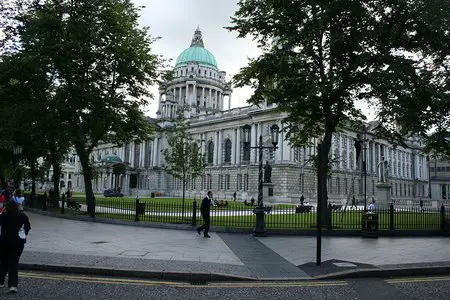
There is a huge collection of portraits of Lords and Mayors of Belfast in the upper floor hallway; one of the most visually striking areas of the City Hall. Take a free guided tour and you will be able to sit on the Mayor’s throne in the Council Chamber and try on a robe in the Robing Room. Know about the origin of Belfast, its meteoric rise into prosperity, its phenomenal success in the areas of linen making and maritime industry.
Also, know about the symbolism of the Belfast Coat of Arms and the hundreds of stories hidden inside the stupendous collection of stained glass windows inside the City Hall. If you are short on time then a walk through the 16 different themed rooms in the Visitors exhibit room will also let know Belfast intimately. The Titanic’s connection with the City Hall is remarkable (the mayor was on the governing body of Harland shipbuilders).
The poignant Titanic memorabilia here including the ice and water-themed garden and the plaque commemorating all those who died on the ship is no less interesting than the Titanic Belfast experience.
If you love symbolism and are even mildly interested in history then the City Hall is a must-visit…its like symbolic art and architecture containing references to all events (post potato famine, strikes, cattle raids, protests) and people and important to Belfast.
Read: How to visit and take a tour of Belfast City Hall
Belfast Botanic Gardens
Just a few minutes away from Belfast City Center, adjacent to the famous Queen’s University there is a Botanical garden that has captivated the hearts of tourists and locals alike for years. Since its inception in 1828 when the ‘ Royal Belfast Conservatory’ started to weave marvels in horticulture to 1869 when head gardener Charles Kimm created the alluring Tropical Ravine to the recent 2019 when ‘The Global Medicinal Garden’ was created; the Botanical gardens has been set pretty high standards.
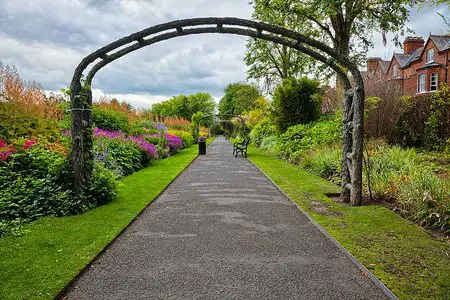
The Palm House conservatory for example houses plants from far away climes like the giant Australian Lily and needs to have its body white washed ever summer so that these plants get a perfect environment. The herbaceous border of blooms, perennials and bamboo foliage is 2000 sq. meter; one of the longest in the UK.
The Rose Garden sports more colours than you can name and each patch contains just one variety of rose with neat grassy picnic-perfect plots in between. There is a children’s playground, a special toddler’s play area and even a vibrant bandstand that holds rock concerts and musical extravaganzas from time to time.
Walk into the Botanical gardens to see a perfect slice of local life; people bring their pets for a walk (with pet poop scoopers in hand) and couples sit for a date while kids are seen admiring the piranhas in the Tropical Ravine. Just reading all the signage around will give you a nice botany lesson but if you want more then just head over to the famous Ulster Museum that also sits in the same premises.
Read: What to see & do at the Belfast Botanical Gardens
Ulster Museum
Don’t let the relatively small scale of the Ulster Museum fool you… this is a member of the Irish National Museums and contains one of the most important collections of natural history, applied art etc. Besides being the best demonstrator of North Irish art and culture on the planet the museum mixes the modern and the traditional in a very enticing way.
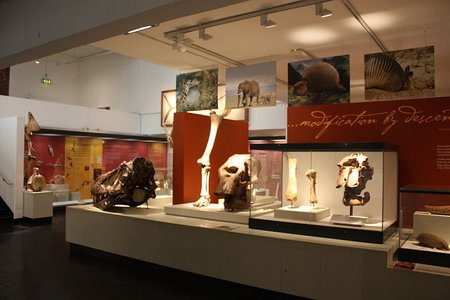
The Ulster is very kid-friendly; the Discover sections are extremely interactive and let visitors do everything from scribbling hieroglyphics to trying their hand at sculpture. The Applied Art Exhibition has a stunning 28 piece medieval toiletry set while the Early People Exhibition has a twisted 720 gm. neck jewellery made of solid gold.
Skeletons of huge fish and dinosaurs greet you while chunks of meteorites from mysterious planets spark your imagination. There is Patrick of Ifold (a giant Irish hound), Peter (polar bear) and a most exquisite collection of blue-green Morpho butterflies which once belonged to the private collection of Marie Theresa. You can find them with other wonders like the 6-foot high Edementosaurus skeleton in the Windows of the World (a multi-level showcase of the museum’s best collections).
Learn afterlife secrets from Takabukti the Egyptian mummy or stare at vintage nuclear toy sets like Gilbert Atomic Lab; the museum offers a startling range of exhibits. The signage friendly and well accessible Ulster museum has Wi-Fi, café and multi-language maps to make the entire experience easier.
Besides the permanent exhibitions, there are a lot of temporary exhibits, tours and workshops for people of various age groups. Ulster Museum is happily placed with the Belfast Botanical gardens near the famous Queen’s University and you can easily spend a whole day exploring this trio of attractions
Read: What to see & Do in Ulster Museum for details.
Cathedral Quarter
It was through a stroke of fate that all the big names in Belfast’s media and culture scenes like Belfast Community Television, Print Workshop Belfast, Sunday World, Irish News, and Vacuum all set up quarters around the historic St Anne’s cathedral. This was long before Lagan Side Corporation christened this area Cathedral Quarter!!
The city’s art community made the quarter their home and a simple walk through Hill Street, York Street and the intriguing Umbrella Passage will let you know that the most of Cathedral Quarter is an open art gallery. Metropolitan Art Centre on Edward Street and Black Box on Hill street present theatre, workshops, music shows and exhibitions while live concerts and shows are organised on Custom House square.

The eye-catching spire of St Anne’s Cathedral has a story to tell and so does North Ireland’s biggest chandelier that glitters inside the Merchant Hotel. Drop into the Ulster University student Union building and take pictures of the punk art around or knock on the Game of Throne’s door at the Dark Horse pub. Go on a street art tour and see what the last edition of Culture Night has added to the streets. When it’s the Cathedral Quarter, there is never a shortage of things to explore!!
Read: What to see and do at Cathedral Quarter for complete details.
Parliament Buildings
Sadly, the name ‘Parliament buildings’ is a misnomer as there is only one building here though three were planned (executive and judicial branches of government). It is also largely non-functional apart from sporadic assembly meets as the power-sharing coalition collapsed after the 2017 heat incentive scandal. The building, however, breathes magnificence right from its 6 storeyed, six columned structure to its Great hall with its chandelier and red-blue-gold ceiling.
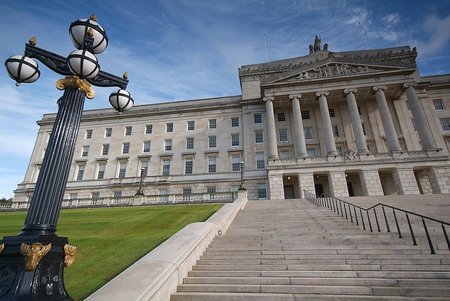
The guides will walk you through a free tour of North Ireland’s history, architecture and royal trivia as they explain how the Stormont estate passed from the hands of the Cleland family to the government and how its rooms were used by the RAF during WW2.
It’s a sacrilege not to visit the other parts of the green flag holder Stormont Estate… there is the Mo Mowlam’s Children’s Park, Outdoor gym, ancient Stormont Castle, acres of woods and lovely activity trails. Accessible, inclusive, free and historically important; the buildings and the estate are one of Belfast’s richest treasures.
The Hop on Hop off city sightseeing bus also covers the Stormont estate on its route. Don’t forget to participate in the delectable afternoon tea session at the Members’ Dining Room before you leave… rumours are that the best scones and sponge cake are served here!!
Read: What to see and do in Parliament Buildings of Belfast.
 A travel addict. Still celebrating the day when he quit his high-profile corporate job to pursue his passion for travel writing.
A travel addict. Still celebrating the day when he quit his high-profile corporate job to pursue his passion for travel writing.